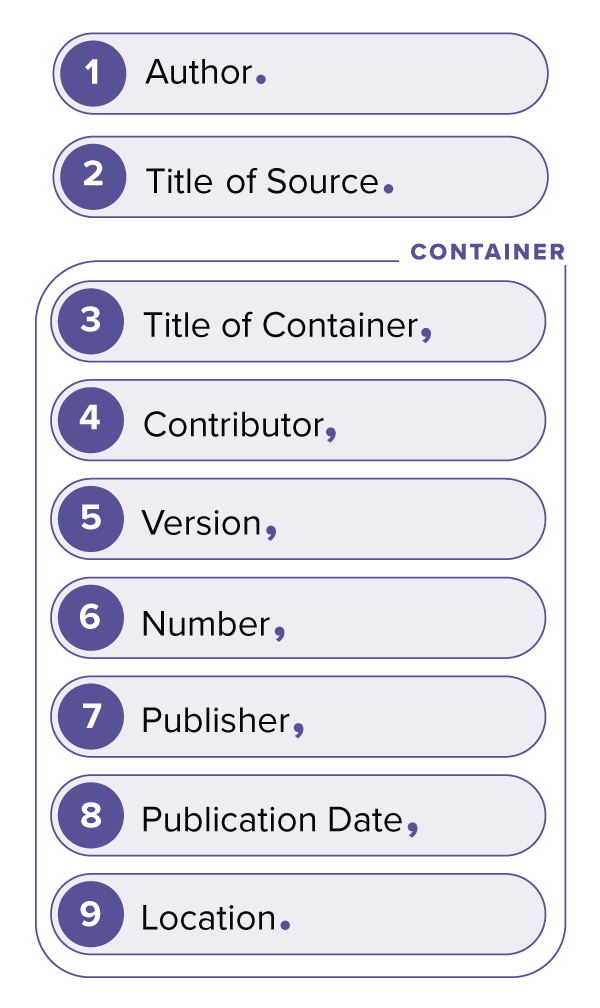Basic Format:
Author Last Name, First Name Middle Name or Initial. Title of Longer Work or "Title of Shorter Work." Publisher, Year. URL or DOI.

Core Elements
Each entry in the list of works cited is composed of facts common to most works—the MLA core elements. They are assembled in a specific order.
Containers
The concept of containers is crucial to MLA style. When the source being documented forms part of a larger whole, the larger whole can be thought of as a container that holds the source. For example, a short story may be contained in an anthology. The short story is the source, and the anthology is the container.
Practice Template
Learn how to use the MLA practice template to create entries in the list of works cited.
"Prompt". AI tool, version date, Owner or sponor of AI model, date accessed, URL
“Describe the symbolism of the green light in the book The Great Gatsby by F. Scott Fitzgerald” prompt. ChatGPT, 13 Feb. version, OpenAI, 8 Mar. 2023, chat.openai.com/chat.
If accessed online or in a library database...
Gosine, Kevin, and Emmanuel Tabi. "Disrupting Neoliberalism and Bridging the Multiple Worlds of Marginalized Youth via Hip-Hop Pedagogy: Contemplating Possibilities." Review of Education, Pedagogy, and Cultural Studies, vol. 38, no. 5, 2016, pp. 445-467. Research Gate, doi: 10.1080/10714413.2016.1221712.
Cochrane, Emily, and Noah Weiland. "Hillary Clinton, the N.F.L., Roy Moore and Other Asides from the President." The New York Times, 16 Nov. 2018, https://nyti.ms/2zf1TPB.
Print Book
Lee, Harper. To Kill a Mockingbird. 1st ed., J. B. Lippincott & Co., 1960.
eBook
Hughes, Langston. Letters from Langston: From the Harlem Renaissance to the Red Scare and Beyond, edited by Evelyn Louise Crawford and Mary Louise Patterson. University of California Press, 2016. EBSCOhost Academic eBook Collection, http://libproxy.csudh.edu/login?url=https://search.ebscohost.com/login.aspx?direct=true&db=e000xna&AN=1105577&site=ehost-live&scope=site&ebv=EB&.
Green, David. "Supporting the Academic Success of Hispanic Students." College Libraries and Student Culture: What We Now Know, edited by Andrew D. Asher and Lynda M. Duke, ALA Editions, 2011. EBSCOhost Academic eBook Collection, http://libproxy.csudh.edu/login?url=http://search.ebscohost.com/login.aspx?direct=true&db=nlebk&AN=390319.
"MLA Style - 9th Edition." Felician University Library, https://felician.libguides.com/mla9.
Songs, Recordings, and Performances
Song from an Album
Snail Mail. “Thinning.” Habit, Sister Polygon Records, 2016. Vinyl EP.
Song on a website
Snail Mail. “Thinning.” Bandcamp, snailmailbaltimore.bandcamp.com.
Concert Attended in Person
Beyoncé. The “Formation” World Tour. 14 May 2016, Rose Bowl, Los Angeles.
Movies, Videos, and Television Shows
A Movie Viewed in Person
Opening Night. Directed by John Cassavetes, Faces Distribution, 1977.
A Movie Viewed Online
Richardson, Tony, director. Sanctuary. Screenplay by James Poe, Twentieth Century Fox, 1961. YouTube, uploaded by LostCinemaChannel, 17 July 2014, www.youtube.com/watch?v=IMnzFM_Sq8s.
A Television Show Viewed on Physical Media
“Hush.” 1999. Buffy the Vampire Slayer: The Complete Fourth Season, created by Joss Whedon, episode 10, Mutant Enemy / Twentieth Century Fox, 2003, disc 3. DVD.
A Photograph Viewed in Person
Cameron, Julia Margaret. Alfred, Lord Tennyson. 1866, Metropolitan Museum of Art, New York City.
A Painting Viewed Online
Bearden, Romare. The Train. 1975. MOMA, www.moma.org/collection/works/65232?locale=en.
An Untitled Image from a Print Magazine
Karasik, Paul. Cartoon. The New Yorker, 14 Apr. 2008, p. 49.
Check out more examples of citing online sources from the MLA Style Cetner.
Boroff, Marie. Language and the Poet: Verbal Artistry in Frost, Stevens, and Moore. U of Chicago P, 1979.
—. "Sound Symbolism as Drama in the Poetry of Robert Frost." PMLA, vol. 107, no. 1, Jan. 1992, pp.131-44. JSTOR, https://doi.org/10.2307/462806
Style a source in an annotated bibliography just as you would one in a list of works cited, and then append an annotation to the end of the entry, indented an inch from the start of the entry. See template below.
Basic Writing and Format Tips:
Start with the same format as a regular References list.
After each citation, the annotation is indented two spaces from the left margin as a block.
Each annotation should be one paragraph, between three to six sentences long (about 150-200 words).
All lines should be double-spaced. Do not add an extra line between the citations.
If your list of citations is especially long, you can organize it by topic.
Try to be objective, and give explanations if you state any opinions.
Use the third person (e.g., he, she, the author) instead of the first person (e.g., I, my, me).
Annotations
An annotation is a summary and/or evaluation. Therefore, an annotated bibliography includes a summary and/or critical evaluation of each of the sources. The annotated bibliography looks like a References page but includes an annotation after each full citation.
Annotated bibliographies can be part of a larger research project, or can be a stand-alone report in itself.
Depending on your project or the assignment, your annotations may do one or more of the following:
Summarize
Some annotations merely summarize the source. What are the main arguments? What topics are covered? The length of your annotations will determine how detailed your summary is. Who wrote the document? When and where was the document written?
Assess
After summarizing a source, it may be helpful to evaluate it. Is it a useful source? How does it compare with other soruces in your biliography? What is the goal of this source?
Reflect
Once you've summarized and assessed a source, ask yourself how it fits into your research. How does it help shape your argument? How can you use this source in your research project?
Your annotated bibliography may include some of these, all of these, or even others. If you're doing this for a class, you should get specific guidelines from your instructor.
